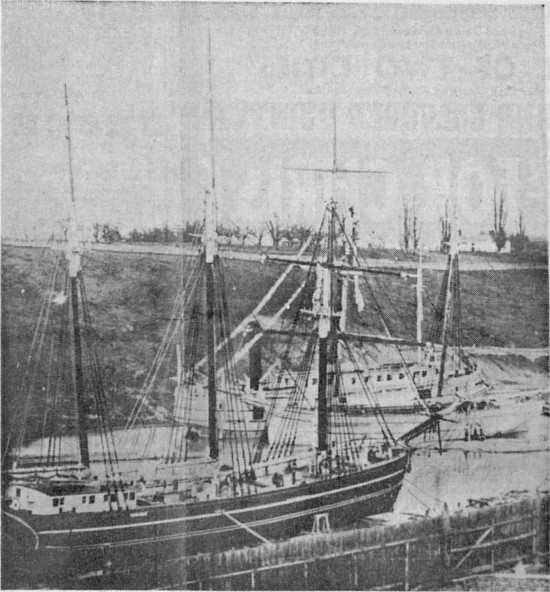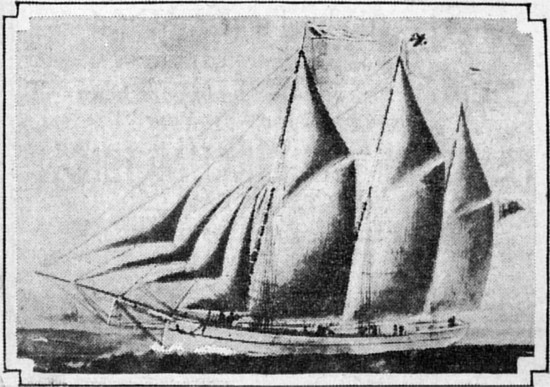The Pickled Prince
Toronto Telegram, 30 December 1944
SchoonerDCLXXIII (673)
By C.H.J. Snider

WHEN Adamson’s Elevator, at the end of West Market street, fell down thirty years ago, with its bins filled with crushed stone instead of the wheat and barley which had filled it thirty years earlier, it dropped on a grimy tow barge which was lying in the slip alongside, like an a old cow ruminating upon the greenness of the pastures she had known as a calf. Workmen pried loose the torn strips of galvanized iron and the dusty planks and timbers which then completely hid the barge from view, and a dipper dug into the heaped-up stone pile until the battered old hero came up for air. She had been pressed to the bottom of the slip – which wasn’t far – with the thousand-ton weight on her, but her timbers had stood the strain without cracking and she was ready to bring in another cargo of crushed stone from Point Ann as soon as there was another elevator ready to unload and store it.
“And why shouldn’t she?” demanded old Nosey O’Brien, the Nestor of the waterfront. “She went across the Atlantic Ocean without leaking a drop so why should she fall apart in a market slip for a few thousand tons of stone? And her heir to the crown of England, too, mind ye.”
The name in blistered paint on her stern was Sligo of St. Catharines. She was looked up in the Dominion Register and sure enough a three-masted schooner of that name was found recorded as built in St. Catharines in 1874. It was not difficult to trace in this battered tow barge the lineaments of an “Old Canal size three-and-after.” But all the inquiry from that day to this failed to find any record of the schooner Sligo crossing the Atlantic or having royal blood in her veins, though there were enough Norrises and Conlons and Battles and Neelons among the Keltic kings of the Welland Canal zone to justify the choice of the name of “Sligo port below” for any St. Catharines schooner. And there was the interesting record of the Sligo having carried the first grain cargo out of Fort William – 17,000 bushels in 1883, trundled aboard in wheelbarrows pushed along planks over her rail. And another interesting record of how she got to Lake Superior, neither schooner nor crew ever having been there before.
REGARDING this last exploit, it seems that in 1878 John Ross, of Montreal, railway contractor, chartered her after she had been in the timber trade for four years, to carry machinery of all sorts to Prince Arthur’s Landing, as the later Port Arthur was known, for the building of a hundred-mile section of the Canadian Pacific Railway west from Nipigon.
Capt. J. J. Daley, Mate Pat Deasey and a St. Catharines crew worthy of the name Sligo brought the schooner to Toronto. At Sylvester Bros, wharf, at the foot of Church street, where was the biggest derrick on Lake Ontario, they loaded an old Intercolonial dinkey engine on deck, and in the hold put 250 tons of iron rails and black powder, picks, shovels, hexagon steel bars for drills, wheelbarrows, sledges, hay, oats and cattle feed for the horses and horned beasts then being imported into Algoma. Lake Superior was then not much better known than the Sahara Desert, but off they sailed for the Sault River. They had no tug and no pilot and had never been up there before, but up they went by way of Lake George, with the kedge a-cockbill, the lead going all the time and Jack Daley growling “port” or “starboard” to the man at the wheel as Pat Deasey hailed less or more water. So they got as far as Sugar Island, where you have to turn to the westward, and here they anchored. As soon as they got an east wind they hove up and went on as before and sailed right up the river to the old wooden lock at the American Soo.

This lifted the ship up 20 feet, and still unaided by a tug she said out of the canal into the river again, past Gros Cap, and into Whiskey Bay, where the Sligo began to taste the “wine of the country,” viz., Superior’s 40-degree Fahrenheit waves.
Off Cariboo Island came rain, then snow from the northeast. And this was well into June! Double reefing her all around they stood by, and had four days of snow, wind, fog and vapor from the water.
“On the first day,” said Capt. W. D. Graham of St. Catharines (the captain made this voyage in the Sligo in his twenties) “we lay becalmed, fog thick as hair on a dog, the booms hanging in amidships, not a breath of wind. The hash hammer (cook’s bell) sounded for breakfast. We gulped it down in the usual fifteen minutes and came on deck to see Thunder Cape coming out from the fog about four miles to starboard of us, Pie Island ahead and Isle Royale astern, with Mount McKay rising strong to the westward.”
What a sight for these lower lake men who had never sampled Superior’s grandeur before! They reached Prince Arthur’s Landing in the afternoon. Tom Marks had a general store there, and he and the few whites and all the Indians and husky dogs turned out in mass formation. The only wharf was three sunken cribs covered with corduroy logs.
Here the Sligo discharged her perilous and ponderous cargo in safety, none of the powder getting wet or going off and the dinky engine traveling away on her own rails. The schooner carried 22,000 bushels of oats to Collingwood from Chicago in October, 1878, and corn in 1879, and came to Lake Superior again within five years for the C.P.R. construction work which crept along the north shore year after year. Capt. Mike Kerwin had succeeded to her command.
Like many another tall schooner, the Sligo was turned into a tow barge because it was cheaper to buy coal to tow her than to pay sailors to sail her. She jogged along for some time after the elevator fell on her, and might have been jogging yet, for she seemed to be as miraculously preserved from decay as the famous one-hoss shay. But to facilitate the loading and unloading of the crushed stone they widened her hatches from covering-board to coveringboard, and that was like cutting her backbone through. She wriggled in a seaway like a rattlesnake with the colic, and went down off Sunnyside with a load of stone in deep water about 1913 and there she lies.
All this casts no light on Nosey O’Brien’s cryptic remark that she was the heir to the crown of England and had been across the Atlantic but the old man was never wrong.
The same Captain Graham already quoted solves the mystery. We had noticed in the old S4, Catharines and Port Dalhousie register that a “barque” named the Prince of Wales was entered as “broken up” in 1874, and asked him why. Quoth he:
“The barque Prince of Wales was built for Capt. J. C. Graham, her master and owner, by Lewis Shickluna in St. Catherines in 1860. The late King Edward VII, when eighteen years old, was visiting Canada that year. He was staying at the Queen’s Royal Hotel at Niagara-on-the-Lake at the time and came to St. Catharines for the launching. He christened the vessel with the usual champaigne, for she was named Prince of Wales in his honor.
“She was really a fine product of Ontario shipbuilding. She had two complete suits of sails and was built about five feet deeper than the ordinary canal-sized vessels of her time. On her foremast she crossed three yards for square sails. Her mainmast and mizzen were fore-and-aft rigged. She was a true barquentine. On the lakes we called them barques. Her standing rigging was hemp. Wire rigging and double topsails were coming in, but she had a single topsail with three reefbands in it, and all her rigging was rope. She had five thick rope shrouds on either side of her foremast, besides rope backstays and headstays, all tarred to protect them from the weather.
“Having a charter to carry a cargo of coal oil in barrels from Cleveland, Ohio, to Liverpool across the ocean, she loaded all she could carry on a 9-ft. draught down the St. Lawrence canals, and on reaching Montreal loaded several hundred barrels more which had been shipped by rail.
“Clearing the St. Lawrence, off Newfoundland she made good weather of the rough going, but the heavy sea and the angle of heel put so much pressure on the lower tiers of barrels in her hold that they were crushed flat. She did not take any water aboard, and none through her bottom, but on sounding the pumps oil was found in the limbers, and the crew pumped oil all that trip.
“There was an oil slick across the ocean from Newfoundland to Liverpool in the wake of the Prince of Wales, and she ran dry as a carpet slipper all the way. Arriving in Liverpool when the top two-thirds of her cargo were discharged there was nothing left below but crushed barrel staves and a reek of petroleum that would wake the dead. She was oil from stem to stern, she had been swimming in it, and days of sanding and scrubbing made no difference to the smell.
“The only return cargo she could get was iron rails for the Great Western Railway which ran from Clifton to Windsor. In Toronto, at the foot of Yonge street, when she came back, Capt. Graham said he had made the round trip and never lost a rope yarn, on lake or ocean.”
Tween-decks, taking the weight of the upper tiers, would have prevented the crushing of the lower ones, but this would unfit her for bulk cargoes, so shortly after her return from overseas she was cut down to Welland Canal draught. Her new registered dimensions were 138 feet on deck, 23 feet beam and 11 feet 8 inches depth of hold; 335 tons register. Before being cut down she registered 509 tons and could carry a thousand.
Her rig was changed to a “three-and-aft” schooner, the barquentine foremast, which was in three sections, being replaced by a schooner’s lower mast and topmast. Possibly a new ceiling qualified her for the grain trade. The drenching with coal oil would certainly make her none the worse for the timber trade, in which she was engaged for many years. Her timbers being soaked with coal oil to a depth of three or four feet was the secret of her longevity.
